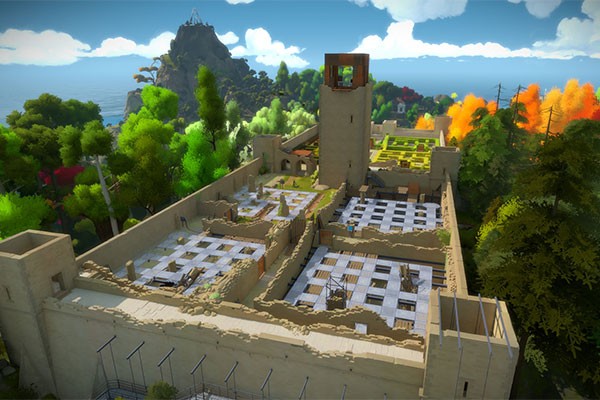Rating: A
It is hard to make a player feel completely alone in a game and still keep them engaged. It is even harder to make a puzzle game that treats the player intelligently while forcing them to learn new problem-solving skills. The Witness is the latest puzzle game from game designer Jonathan Blow, most famous for his time-bending puzzle-platformer Braid in 2008. That was a game that utilised its two-dimensional art style very impressively: it implemented time-manipulation mechanics alongside basic Mario-style platforming to subtly teach players how to solve its puzzles. The Witness moves this kind of puzzle-teaching into three-dimensions, and makes a game that is quiet, awe-inspiring, shatteringly beautiful and contemplative.
The Witness is very heavily inspired by the 1993 point-and-click adventure game Myst. Both are puzzle games, both are set on an abandoned island, both have an emphasis on exploring the gorgeous environment, and both have an unsettling, empty atmosphere. Every element of The Witness’ aesthetic design is breathtaking, from the pastel-colour architecture of the island itself to the exquisite sound design. However, while Myst relied on combination-based puzzles, the puzzles in The Witness are deceptively complicated. Each of the roughly 700 puzzles in the game looks almost identical: each consists of a grid of squares, and each is solved by drawing a line across the grid from point A to point B. This sounds childishly simple, but it is not.
The difficulty of the game comes from the introduction of different puzzle elements, indicated by symbols on each grid. Coloured squares indicate that you must divide the grid according to the squares’ colour; tetris blocks indicate that you must draw a particular shape on the grid; and dots indicate paths that the line must cross before it reaches its end. Each puzzle element is introduced gradually, with very simple puzzles teaching you how they work before the puzzles get more complicated. Once you have explored and unlocked more of the island, the puzzles start combining elements and becoming more abstract. The puzzles towards the end of the game are infuriatingly difficult, and a walkthrough will not necessarily help: even if you learn what the solution to a puzzle is, you may not have learned WHY that was the solution.
There could easily have been a great disparity between the grid puzzles and the environment. The two appear to have nothing to do with each other. Thankfully, the environment is incorporated into the puzzles in a variety of ways. One particular puzzle has multiple solutions, with each permutation changing the position of a swampy bridge. The solutions for another series of puzzles are influenced by the positions of shadows cast by surrounding tree branches. Another series of grid puzzles revolves around navigating through hedge mazes lined with pressure-activated platforms. Almost every way in which the puzzles could have been integrated into the environment is explored.
The one main down point of The Witness is its story. Throughout the game, I got the impression that a fragmented culture of some kind lived on the island. Disparate statues show the residents’ occupations a la Bioshock Infinite, and a variety of locations and machines demonstrate the inhabitants’ hobbies and means of surviving. Even the title, “The Witness”, implies that some crime or disaster has taken place on the island and you are it’s only survivor. However, without spoiling anything, this is a red herring. If you are expecting a giant revelation at the end, you will find the game building up to what you think is one, and then you will be sorely disappointed.
Fortunately, one does not need to play The Witness for its story. It is a beautiful and atmospheric puzzle game, and that is all it needs to be. Even if the plot hints lead to nothing special, they cast an aura of mystery around the island that is oddly seductive even if one knows the ending. And if you do know the ending (and its secret endings), the game and the island become puzzles in themselves, leaving players to guess why Jonathan Blow would have designed the game to be so esoteric and so softly metafictional. The Witness is a masterpiece of integrated game design, and one that is well worth your time and mental energy.



